One of my preoccupations in painting inhabited space is to see how people perceive and decorate their surrounds. In cities, it seems to me, conformity sometimes rules — or perhaps there’s too much unconformity to make sense of a singular type of decorative decorum. Whatever the case, I find that peering at small towns and villages gives me a certain kind of data; both individually and collectively, people seem to want to dress up, decorate, make order of what lies around them. And in places with few people, it’s possible to suss out what that decorative impulse consists of.
A particular caution that I remind myself of — looking at what people do to dress up their trailer houses requires a disciplined mind. My goal is to neither romanticize nor to satirize. I allow myself no irony about individual choices, although lots of irony can abound when examining communal structures (like bridges and mine tailings). What I want is to see what’s there without indulging in judgment.
So what is the predominate beautification element of Beatty Nevada ( 220 miles south of Reno, 110 miles north of Las Vegas, population 1200, where the Amargosa River surfaces, just for a minute, before being swallowed by the Amargosa desert [a subset of the Mojave desert])?
Well, mostly it consists of rocks.
The city stockpiles them in the multiplicity of vacant lots around town.
The post office shows them off.
The best soup and sandwich shop in town (as well as the only one) uses them as grass would be used elsewhere.
True there is at least one person in town who loves a variety of decorative elements (and perhaps indulges in a bit of irony of his own.)
But even the owner of the Beatty Club (above and below) on Main Street, formerly a place to buy food and drink and now a warehouse for “stuff,” has some of his creations sitting on rocks.
The Bank of America (here the irony makes itself) makes use of the local home decor.
And someone with lots of energy and a strong back built a stone garage.
It makes sense, of course. Rock here is all around — millions of years of flash floods have pushed boulders out onto the desert floor, beautiful rocks, rosy, green, metallic, gold. Not much vegetation, too sparse for cows, but tons of magnificent rocks. And people here see and appreciate the qualities of rock, just as I have, in making a growing rock circle/maze from my days at the isolated Red Barn Residency.
The housing stock in Beatty is 90% trailers. One might think that’s because of the average income level, but in other small, economically poor towns, Basin, Montana, for example, there were far more conventional wooden and brick houses. The reasons for the ubiquitous trailer is obvious: no wood, except creosote bushes and mesquite and soft cottonwood, exists naturally for miles and miles. There’s no clay to make bricks. And building stone houses now requires rebar, experienced stone layers, and structural devices that drive up the price. Stone houses tend to be inflexible, small, dark, sometimes inconvenient for utilities. So trailers abound, ranging from converted school buses to double wides that have been stuccoed to look like traditional adobe dwellings. They have air conditioning, heating, carpeting, running water, all mod cons, and can be transported along Highway 95 quite easily. Almost certainly, if Jer and I were to live permanently in Beatty, we’d be in a double-wide with a heavy-duty chain link fence, perhaps disguised by creosote and greasewood bushes. We’d have a rock-laden yard, with a rock strip between the sidewalk and the street, and we’d hire someone with a stong back (or a big machine) to lay some gorgeous rocks along the walkways, just for sheer pleasure of seeing them every day.
So painters go to Tuscany to paint the villas or to Peru to paint the markets. In 2000 years people may come to Beatty to discover how the indigenous peoples lived. They will photograph the remains of the structures, and note the use of rock as an important, yet not very utilitarian, element.They will come to paint the remains of the civilization, imagining what it must have been like, back in 2010.
So, what observations have you made about the common use of decorative elements in your neighborhood. What do the natives do to their external surrounds to make them attractive or rational? What native materials do they make use of? What native materials do you make use of?
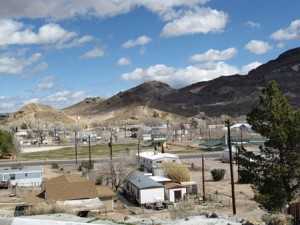
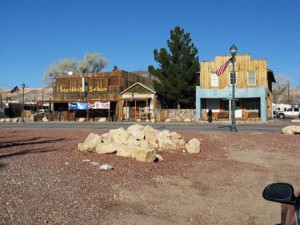
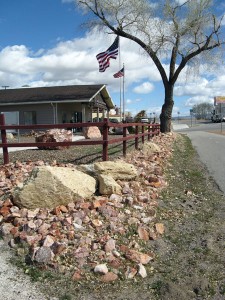
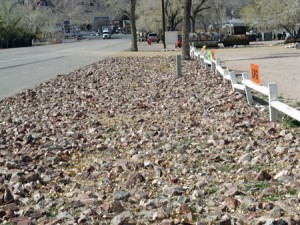

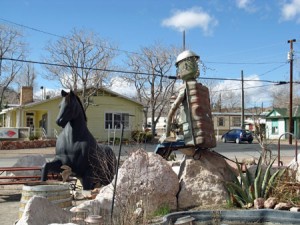
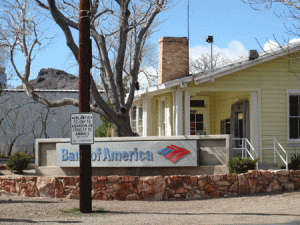
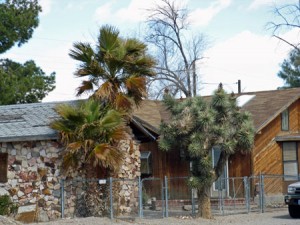
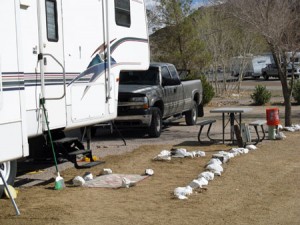
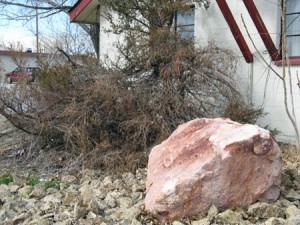

Hello June:
My limited experience with desert communities would suggest that living things can be a major factor. Your shot of Beatty features a tree and some struggling grass on a far field. They stand out in an otherwise bleached and rocky place.
June,
You remind me of my friend Leslie who once had a desert garden with its original crumbly rock surface, not white pebbles from Home Depot like some of her neighbors in her Phoenix suburb.
Where I spent time? Grass or ground cover, some flowers around the houses in East Lansing. Long boxes with bright geraniums bloom at the windows in the hallway of Troels’ NYC apartment. ‘Up North’ in MI, we like it natural, meadows, forest.
I am partial to rocks in which I see faces – one-eyed, two-eyed people. I have a few of those around the house up North.
Here in Holland trees are a big repeating pattern. They are planted alongside the roads along canals to strength the earth. Each year they are carefully trimmed so that they have the appearance of a poodle appendages.
Here in Montana, I like to decorate the yard with…rocks! They line the garden patches and are inset for footpaths. Most are gathered from the nearby mountains. I always have an eye out for worthy additions.
My favorite yard rock of all time I found not far from Beatty, just over in Death Valley near Corkscrew Mountain. It was a pastel purple/pink and had a texture like rain-spattered mud. It was flagstone-flat and the shape strongly resembled that of the continental U.S. I knew it was a keeper as soon as I saw it, yet we were in the middle of a rock-strewn plain and didn’t want to carry it up the mountain and back. So I looked around carefully and left it. I don’t remember what I used as a landmark, but I did manage to re-find it on the return to the car. It went with us first to California (north and south), then to Minnesota, and then was passed to others. I believe it currently resides in Toronto.
Hi Jay,
While any foliage stands out in this landscape (creosote bushes, greasewood), it is so rare and hard to maintain that, particularly where there is any walking at all, it disappears. There are some pine trees (I don’t know the kind) in Beatty, and cottonwood grows along the river. That said, the predominate aesthetic is still rock. I didn’t show the enclosed space (“yard” doesn’t sound quite right) around the house we are living in, but along with a couple of carefully tended trees, a totally barren flat where grass might be in other places, there are hundred of good sized rocks, piled around the trees and lining the fences some of them are gorgeous.
I suspect the bits of foliage that exist are so noticeable because they are rare. One of my paintings has a big pine tree in it, and another the bones of a wonderful mesquite. It’s hard to paint without the softening influence of foliage, except when one is doing far away landscapes. The mountains here are a geologist’s paradise — no trees (or grass or bushes or scrub) in the way.
Birgit,
I like the thought of rows of geraniums — in Kansas, because they like a certain amount of heat, geraniums and marigolds predominated. Rocks showed up occasionally, but weren’t a major aesthetic. Square, well-defined, large plots of land — city plats and farming acreage — all done in neat, directionally defined squares seemed to be important. Defining one’s territory, I think, sometimes in rectangles, but mostly squares.
In Pennsylvania, the towns tend to follow the natural features of the land — curving around rivers and climbing hills in stairsteps. When I was growing up, the aesthetic was to get rid of the foliage and have a nice clear view. That may have changed.
In Portland, it’s all foliage and flowers, particulary foliage and flowers that are out of control, English garden style. No bare spot allowed to appear. Found art in yards and plastic ponies on the old hitching rings has gathered some use in the last ten years — purple straight back chairs and painted foam pie plates nailed to fences come to mind.
Steve,
Your story impresses me in two ways — the first is that you could actually carry the rock back to your car — they tend to be heavy…. And you found it again on your way back. I have lost small cairns out here in the desert in places where I swore I would be able to find them again. They just disappear. Even fixed landmarks like open mine holes in hillsides can get lost. The distances are so vast and the air so clear that one is deceived by them; and the sheer number of rocks makes them all look the same.
I’m also thinking of a coffee table made out of heavy planks and sawn tree trunks with the bark still on. It had three of these trunk legs, and at at least a couple of parties, someone sat on one corner and everything on the table, mostly drink and snacks, slid gently to the floor. We carried that thing with us for years, but finally, when we moved to Portland, we gave it away. I think it probably has a happy life somewhere, even today.
Karl,
The pollarded trees I remember in France seemed very strange after the wilderness aesthetic I grew up with. In Portland, one of the most popular street trees, (“street” trees are grown between the sidewalk and street and are strictly regulated by the city), are golden ash trees. They tend to grow in round puffs, and particularly in the fall, when some of the excess growth has thinned out a bit, the glow of the ash trees, marching down streets in our neighborhood makes me smile. They are both bureaucratic and touching.
June,
In America, as I recall, they do the same thing with telephone poles.
Karl,
Funny you should mention telephone poles. I am finding that utility poles have become a major organizing factor in my paintings. They are useful in all kinds of ways. But I hadn’t exactly thought of them as “touching.”
Living in New England, telephone poles are just ugly clutter in an already too developed environment. When I go out west, they are one of the few markers in the wide landscape and always entice me to follow them across the great distances they march through. They suggest possibility, and so are rather beautiful and touching.
Actually, Kathy, in Portland Oregon, not New England but somewhat like it, I’ve found the telephone poles to be useful, although in a possibly different way. They change the scene in odd ways — they cut through the romanticization of the nouveau light poles and “nice” street furniture and the lovely foliage. They act as a kind of stop for our eyes, making us see what actually keeps the lights on. I rather like including them in my work, even in the city-scapes. Of course, my city-scapes are a bit wacky and often include fat men hunched over canes and guys on bikes running into UPS trucks, so telephone poles may be just more of the same.
In Beatty, NV,where I am, the iconic building that was once the big casino on Main Street, has become a hardware store — the signs are still up (“The Exchange Club”) with what look like blinking lights and rather garish decor, but below, in the window, the sign says “Keys Made Here.” The local realtor chided me for including”Lou’s Hardware” in my painting; she thought it detracted from the scene. Only in the same way telephone poles “detract,” I think.
Your idea of the poles suggesting possibility, and being beautiful because of that is great — certainly for people, such as those in Beatty who didn’t get electricity until the 1960’s, the possibilities of the poles — for great amenities and comfort — were real.
I think I like the poles too, as you do, as “markers” on the landscape, ways to sort out where you are. However, in the mining towns out here in Nevada, they can be misleading, The mines had electricity when the residences were without, so following the poles now can lead you into seriously desolate country.
Wonderful strange paradoxes. Thanks for checking in.
i used to live there i really miss beatty